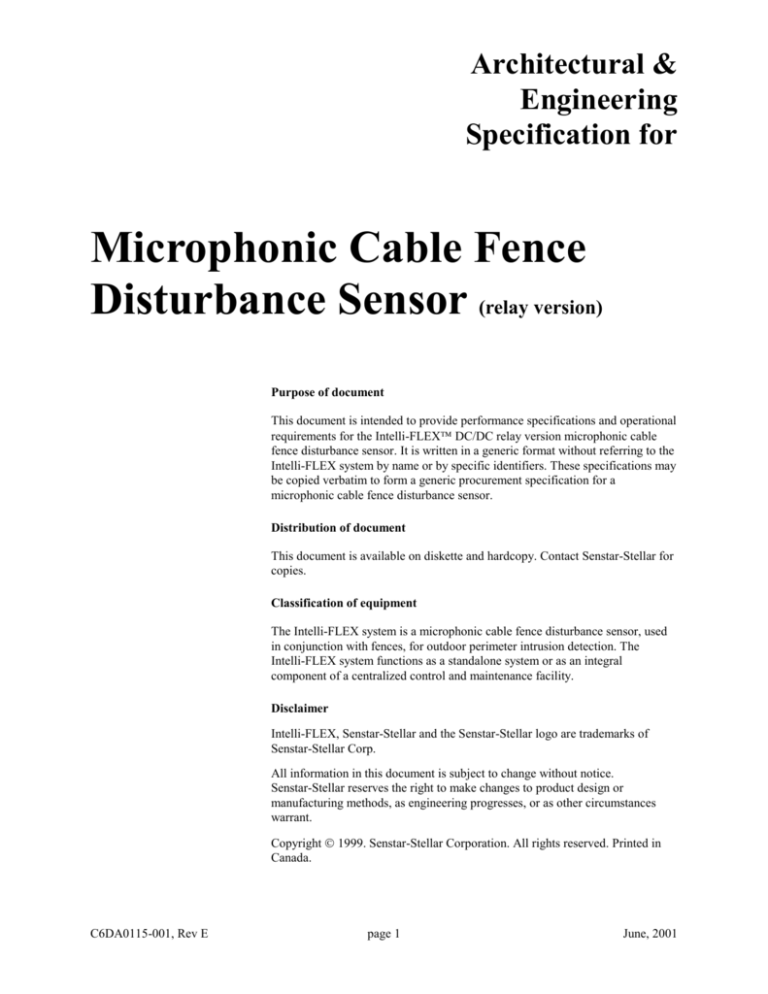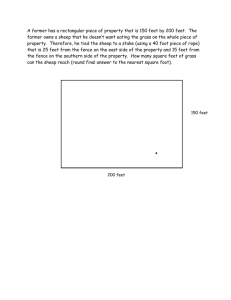
Architectural &
Engineering
Specification for
Microphonic Cable Fence
Disturbance Sensor (relay version)
Purpose of document
This document is intended to provide performance specifications and operational
requirements for the Intelli-FLEX DC/DC relay version microphonic cable
fence disturbance sensor. It is written in a generic format without referring to the
Intelli-FLEX system by name or by specific identifiers. These specifications may
be copied verbatim to form a generic procurement specification for a
microphonic cable fence disturbance sensor.
Distribution of document
This document is available on diskette and hardcopy. Contact Senstar-Stellar for
copies.
Classification of equipment
The Intelli-FLEX system is a microphonic cable fence disturbance sensor, used
in conjunction with fences, for outdoor perimeter intrusion detection. The
Intelli-FLEX system functions as a standalone system or as an integral
component of a centralized control and maintenance facility.
Disclaimer
Intelli-FLEX, Senstar-Stellar and the Senstar-Stellar logo are trademarks of
Senstar-Stellar Corp.
All information in this document is subject to change without notice.
Senstar-Stellar reserves the right to make changes to product design or
manufacturing methods, as engineering progresses, or as other circumstances
warrant.
Copyright 1999. Senstar-Stellar Corporation. All rights reserved. Printed in
Canada.
C6DA0115-001, Rev E
page 1
June, 2001
Architectural & Engineering Specification
for Microphonic Cable Fence Disturbance Sensor (relay version)
June, 2001
Page 2
C6DA0115-001, Rev E
Architectural & Engineering Specification
for Microphonic Cable Fence Disturbance Sensor (relay version)
Contents
C6DA0115-001, Rev E
1.0
General performance specifications .......................5
2.0
Signal processor specifications ..............................8
3.0
System installation and commissioning .............. 11
4.0
System maintenance and repair ........................... 11
5.0
Product certifications .......................................... 11
6.0
System availability .............................................. 12
page 3
June, 2001
Architectural & Engineering Specification
for Microphonic Cable Fence Disturbance Sensor (relay version)
June, 2001
Page 4
C6DA0115-001, Rev E
Architectural & Engineering Specification
for Microphonic Cable Fence Disturbance Sensor (relay version)
1.0
General performance specifications
1.1
System description
The microphonic cable fence disturbance sensor shall function as an electronic
perimeter intrusion detector. The system shall be used in conjunction with fences
to protect the perimeter of a site. The system shall consist of an ultraviolet
resistant triboelectric transducer cable, and a microprocessor based dual zone
signal processor. The system shall be capable of monitoring different styles of
metal fabric fencing such as chain-link, expanded-metal or welded-mesh fence.
The sensor shall detect intruders by utilizing signals generated by the minute
vibration of the triboelectric transducer cable, caused by attempting to cut,
climb, or raise the fence fabric. The system shall be capable of functioning as
either a standalone system or as an integral part of a centralized control and
maintenance facility.
1.2
System technology
The signal processor shall analyze the signals from the triboelectric transducer
cable and shall detect minute vibrations in the fabric of the fence. The processor
shall utilize adaptive algorithms, ambient signal compensation and selectable
common-mode rejection, to discriminate between actual, false and nuisance
alarms, without lowering the probability of detection. The processor shall
identify, by type, a cut intrusion and a climb intrusion. The sensor shall have
independent adjustments and thresholds for each type of intrusion and shall have
the capability to completely mask climb or cut alarms.
1.2.1
Microphonic cable
The transducer shall be an ultraviolet resistant triboelectric sensor cable and
shall be attached to the fence by means of ultraviolet resistant cable ties. The
cable shall generate signals when an attempt is made to cut, climb, or lift the
fence fabric.
1.2.2
Signal processing algorithms
The system shall utilize digital signal processing techniques that employ
adaptive algorithms, capable of adapting to specific fence types and
environmental conditions.
1.3
Detection properties
1.3.1
Detection sensitivity
The system shall detect intruders climbing, lifting or cutting the fence while
rejecting other environmental stimuli. The sensitivity level shall be adjustable for
each zone’s specific conditions.
C6DA0115-001, Rev E
page 5
June, 2001
Architectural & Engineering Specification
for Microphonic Cable Fence Disturbance Sensor (relay version)
1.3.2
Probability of detection
The probability of detection (PD) of an intruder cutting the fence, and for
unaided climbing attempts shall be 95% with a 95% confidence factor.
1.3.3
False and nuisance alarms
1.3.3.1 System-generated alarms (False alarms)
The maximum rate for alarms generated by internal electronic processes (cables
excluded) shall be less than one per zone per year, averaged over the total
number of zones in the system.
1.3.3.2 Environmental alarms (Nuisance alarms)
The system shall operate within specification in typical outdoor environments.
The system shall be installed in accordance with the manufacturer’s
recommendations to minimize the probability of alarms from the following
factors while maintaining the full PD for valid intruders:
precipitation including rain, snow, hail and fog
sunrise/sunset
wind
temperature changes
sandstorms
motion of nearby objects (vehicles, etc.)
motion of surface or underground water
nearby vegetation up to 30 cm (1 ft.) high
nearby sources of radio-frequencies and electro-magnetic interference
seismic vibration
acoustic or magnetic effects
1.3.3.3 Notification of environmental concerns
Before installation begins, the installer shall alert the customer, in writing, as to
all site-specific conditions that may contribute to a higher environmental alarm
rate. The customer shall decide whether to remedy the situation or to accept the
nuisance alarm sources without any further responsibility on the part of the
installer or the manufacturer.
June, 2001
Page 6
C6DA0115-001, Rev E
Architectural & Engineering Specification
for Microphonic Cable Fence Disturbance Sensor (relay version)
1.4
Sensor characteristics
1.4.1
Zone length
The maximum length of each zone shall be 305 m (1000 ft.) of sensor cable.
Individual zone length shall be determined by the physical boundaries of each
zone. The sensor cable shall be supplied in rolls of 305 m (1000 ft.) and shall be
cut to the correct length at the time of installation.
1.4.2
Fence height
For regular chain-link (i.e. not vinyl-coated), welded-mesh, palisade, barbwire,
and concertina fences the following requirements shall apply:
For fence heights up to 2.5 m (8 ft.) high, a single cable, attached at the
midpoint of the fence, shall be adequate for intruder detection.
For fence heights between 2.5 m (8 ft.) and 4.0 m (15 ft.), the cable shall be
deployed in a double pass, with the cables spaced evenly from each other
and the top and bottom of the fence.
For fence heights greater than 4.0 m (15 ft.), the cable shall be deployed in a
triple pass with the cables spaced evenly from each other and the top and
bottom of the fence.
Depending on the height and type of fence, and the level of security required, it
may be necessary to increase the number of cable passes.
1.4.3
Gates
The sensor shall be capable of monitoring or bypassing swinging and sliding
gates by using a Gate Bypass Module. The system shall be capable of placing
monitored gates in access mode (no alarm when the gate is used), or secure
mode within a secure zone, by either local or remote command. The status of the
gate (secure or access) shall be communicated by relay contacts.
1.4.4
Conduit
It shall be possible to install the sensor cable inside conduit that has been firmly
attached to the fence. There shall be no lowering of the PD, or increase in the
rate of false/nuisance alarms, when using conduit that is installed in accordance
with manufacturer’s recommendations.
1.4.5
Armor cable
The sensor cable shall be available encased in an armor jacket, for use in areas
that have a high potential of physical damage to the cable. Armored cable shall
be available in rolls of 100 m (330 ft.) or greater. The armored cable shall be
capable of having multiple sections spliced together to the maximum zone length
of 305 m (1000 ft.). The spliced cable shall meet all specifications without
lowering the PD, or increasing the rate of false/nuisance alarms.
C6DA0115-001, Rev E
page 7
June, 2001
Architectural & Engineering Specification
for Microphonic Cable Fence Disturbance Sensor (relay version)
1.5
Performance history
1.5.1
Previous installations
The system shall have been installed in at least ten similar configurations. A list
of these projects shall be available.
1.5.2
Customer references
The vendor shall submit the names and telephone numbers of at least four users
who shall serve as references for the satisfactory performance of the equipment.
The users shall have a minimum of one year’s performance experience with the
equipment.
2.0
Signal processor specifications
2.1
Signal processor description
Each signal processor shall be capable of monitoring two detection zones. The
processor shall operate either as a standalone unit with local alarm relays, or as
an integral component of a centralized control and maintenance facility. The
processor shall include internal circuitry to protect against lightning and voltage
transients.
2.2
Signal processor operation
2.2.1
Distributed processing
The signal processors distributed along the perimeter shall receive and process
the signals from the sensor cables while providing fail-safe operation. The failure
of one processor shall not affect the signal processing of the other processors
along the perimeter.
2.2.2
Total sensor cable length
Total sensor cable length shall be expandable from the 610 m (2000 ft.)
maximum using one signal processor to an unlimited length using multiple
processors. The detection zone shall be continuous and uniform, and there shall
be no gap between the individual zones, when installed in accordance with the
manufacturer’s recommendations.
June, 2001
Page 8
C6DA0115-001, Rev E
Architectural & Engineering Specification
for Microphonic Cable Fence Disturbance Sensor (relay version)
2.2.3
Alarm outputs
The signal processor shall identify intrusion, fail, and tamper alarms locally by
relay contacts.
Alarms caused by climbing, cutting, or otherwise disturbing the fence fabric
shall be identified as intrusion alarms. Intrusion alarms shall be distinguished
from supervisory alarms.
Alarms caused by power failure, low input voltage, cable fault, or internal
electronic fault shall be identified as supervisory alarms. Supervisory alarms
shall be distinguished from intrusion alarms.
Alarms caused by opening the outer enclosure shall be identified as tamper
alarms. Tamper alarms shall be identified as supervisory alarms.
The local alarm outputs shall be form C relays with n.o./n.c. contacts rated at
0.5 A, 30 VDC.
2.2.4
Self-test
The signal processor shall be capable of self-test by local activation. The selftest will simulate both climb and cut intrusions to fully test the sensor circuitry,
including the cables.
2.3
Environmental operating range
The system shall operate within specifications under the following environmental
conditions:
temperatures between -40 C (-40 F) and 70 C (158 F)
relative humidity between 0 and 95%, non-condensing
2.4
Powering requirements
The processor shall operate at 12 VDC, and shall accept input power from DC
power supplies at:
12 to 15 VDC, for individual unit powering
The individual unit DC power supplies shall accept AC power at 115 V,
60 Hz or 230 V, 50 Hz
18 VDC to 56 VDC, for network unit powering
The network unit DC power supplies shall accept AC power from 85 V to
250 V, 50 to 60 Hz
2.5
Reliability/maintainability
The signal processor shall have a mean time between failures (MTBF) of greater
than 40 000 hours and a mean time to replace (MTTR) of less than 10 minutes.
C6DA0115-001, Rev E
page 9
June, 2001
Architectural & Engineering Specification
for Microphonic Cable Fence Disturbance Sensor (relay version)
2.6
Physical installation criteria
When installed outdoors, the signal processor shall be installed in a
weatherproof, painted steel NEMA 4 enclosure, which meets standard IP 66. A
stainless steel NEMA 4 rated enclosure shall be available as an option. The
enclosure shall include a hinged cover, stainless steel hardware and a tamper
device. The enclosure shall be mounted on a pole, separate from the fence on
which the sensor cables are mounted, on the secure side of the perimeter. Each
processor shall include a suitable ground rod, which is connected to earth
ground.
2.7
Sensor calibration
Each sensor zone shall be capable of being calibrated from its respective signal
processor. Sensor calibration shall be made using a configuration module, which
shall allow the technician to adjust and monitor the response of each zone. The
configuration module shall be detachable via a snap-in connector and shall be
capable of calibrating each of the processors in the system. The configuration
module shall receive power from the processor and shall not require batteries,
calibration or maintenance. Accessing the snap-in connector shall require the
opening of the processor’s enclosure. This action shall cause a tamper alarm to
be generated.
2.7.1
Calibration parameters
The following system parameters shall be adjustable by the user:
Cut detection: independent threshold, count and time per zone
Climb detection: independent threshold, duration and time per zone
Preamp gain: to match the fence to the sensor
2.7.2
Restricted calibration parameters
The following system parameters shall be adjustable by a trained technician,
through the use of a restricted pass-code. These parameters shall only require
adjustment for highly specialized applications:
Ambient compensation: enable/disable, level (for background effects)
Common mode rejection: enable/disable (for environmental effects)
Peak trigger value: (to identify intrusion over background)
Cut profile value: (to better define a cut event over environmental effects)
Alarm output relay activation time: between 0.5 s and 5.0 s
2.8
Audio Module
An optional audio module shall be available to allow an operator to listen to
fence noise to assess possible intrusions. The system shall allow audio
monitoring of each zone separately or any combination of zones over a twistedpair audio cable.
June, 2001
Page 10
C6DA0115-001, Rev E
Architectural & Engineering Specification
for Microphonic Cable Fence Disturbance Sensor (relay version)
2.9
Weather station
An optional weather station shall be available to monitor weather conditions at
the site and to supply the data to the signal processor. The processor shall utilize
the data to increase the level of discrimination between environmental effects
and actual intrusion attempts.
3.0
System installation and commissioning
The system shall be installed and commissioned in accordance with the
manufacturer’s recommended procedures as defined in the product’s installation
and setup guides.
Prior to installation, the installer shall have completed a manufacturer’s training
program and be certified by the manufacturer. Alternatively, the installer shall be
required to have the manufacturer, or their designate, provide qualified technical
support for installation and commissioning.
Acceptance tests shall be performed in accordance with standard procedures
available from the manufacturer.
4.0
System maintenance and repair
4.1
Recalibration requirements
There shall be no need to recalibrate the system after initial calibration except as
the fence condition deteriorates (loose fence elements or wires).
4.2
Sensor cable repair
If the sensor cable is cut or damaged, it shall be capable of being repaired using
additional cable, if required, and an appropriate splice kit. The splice kit shall
require the use of only standard tools (i.e. slot screwdriver, wire strippers, wire
cutters).
4.3
Product support
The product shall carry a minimum one-year warranty from the date of purchase.
The supplier shall warrant that the product shall be supported by spare parts and
assemblies for a minimum of 10 years.
5.0
Product certifications
The product shall be manufactured in accordance with ISO 9002 standards.
For European installations, the product shall bear the CE mark.
C6DA0115-001, Rev E
page 11
June, 2001
Architectural & Engineering Specification
for Microphonic Cable Fence Disturbance Sensor (relay version)
6.0
System availability
A product that meets or exceeds this specification is the Intelli-FLEX
microphonic cable fence disturbance sensor, available from:
Senstar-Stellar Corporation
119 John Cavanaugh Drive
Carp, Ontario
Canada K0A 1L0
Telephone: (613) 839-5572
Fax: (613) 839-5830
Senstar-Stellar Incorporated
43184 Osgood Road
Fremont, CA
USA 94539
Telephone: (510) 440-1000
1-800-676-3300
Fax: (510) 440-8686
Senstar-Stellar Limited
Orchard House
Evesham Road
Broadway, Worcs.
U.K. WR12 7HU
Telephone: (01386) 834433
Fax: (01386) 834477
Senstar GmbH
Riedheimer Str. 8
D-88677 Markdorf
Germany
Telephone: (49) 7544 95910
Fax: (49) 7544 959129
Senstar-Stellar Latin America S.A. de C.V.
Pradera No. 214
Col. Pradera
Cuernavaca, Morelos
62170, Mexico
Telephone: (05273) 130288
Fax: (05273) 170364
Website: www.senstarstellar.com
email: info@senstarstellar.com
June, 2001
Page 12
C6DA0115-001, Rev E







